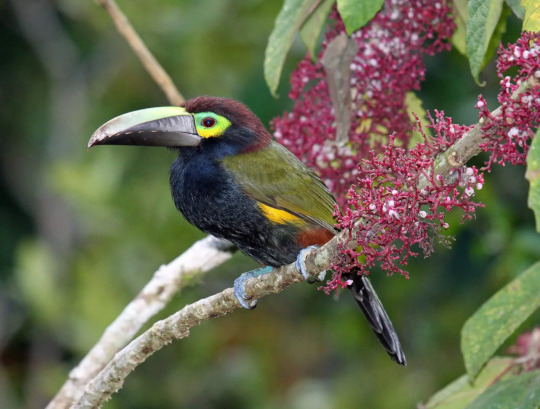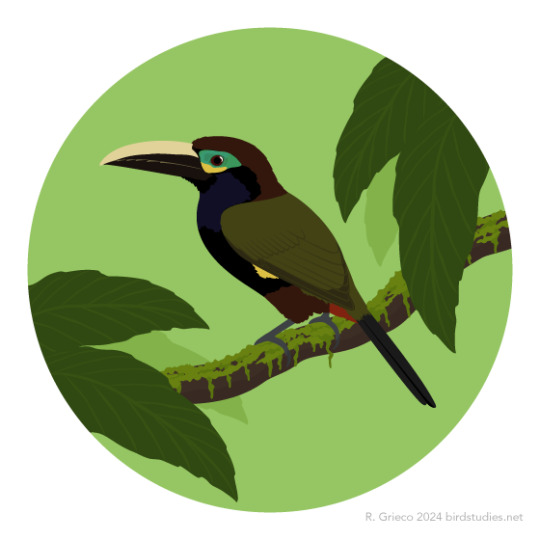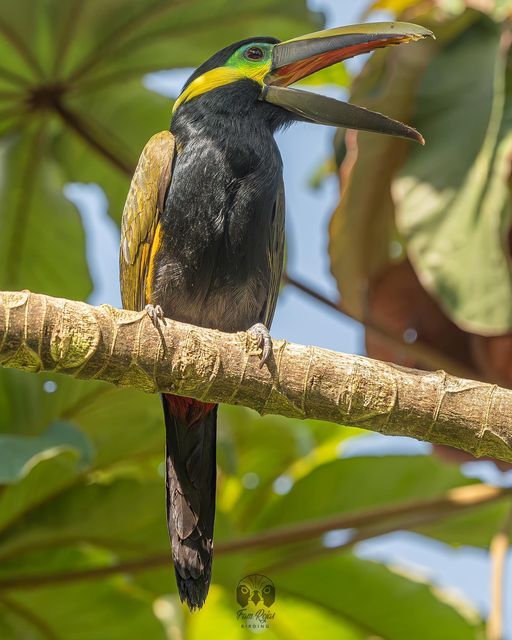#selenidera
Explore tagged Tumblr posts
Text

Yellow-eared Toucanet (Selenidera spectabilis), family Ramphastidae, order Piciformes, Costa Rica
photograph by Jean Bonilla Portuguez @wildlife_journeys_cr
1K notes
·
View notes
Text
BOTD: Yellow-eared Toucanet

Photo: Cathie Barron
"Small toucan with distinctive plumage pattern. Male has black body with bright yellow cheek patch; also note olive back and orange patch on flanks. Female similar; she lacks the yellow cheek patch but still has bright yellow-teal skin around the eye. Found in the forest canopy, usually in pairs or small family groups. Feeds on fruits, and sometimes perches conspicuously on an open branch."
- eBird
#birds#yellow eared toucanet#birds of north america#north american birds#toucans#toucanets#birds of central america#birding#bird watching#birdblr#birblr#bird of the day#Selenidera spectabilis
108 notes
·
View notes
Text

March 15, 2024 - Yellow-eared Toucanet (Selenidera spectabilis) Found in parts of Honduras, Nicaragua, Costa Rica, Panama, Colombia, and Ecuador, these toucans live in and around mountain and lowland forests. They eat fruit, insects, spiders, and lizards, foraging in pairs and small flocks. Little is known about their nesting behavior, though they may primarily breed between April and August and perform courtship displays while singing. Females are thought to lay clutches of two to four eggs.
#yellow-eared toucanet#toucan#selenidera spectabilis#bird#birds#illustration#art#tropical#birblr art
84 notes
·
View notes
Text

spot-billed toucanet (Selenidera maculirostris) by João Ferraz
0 notes
Text
BIRD WHEEL: Golden-Collared Toucanet

@/thatonerandompigeon

@/baneobeees
The Golden-Collared Toucanet or Selenidera reinwardtii are very handsome little guys! They live in the north of South America in mature upland rainforest. Males have are black above and brown below with yellow eye patch, while females are different with red-brown above.
#bird#birds#bird art#daily birds#birdblr#daily bird#birdies#daily birds art#daily bird art#WHOA BIRDS#pigeon#birb#golden-collared toucanet
18 notes
·
View notes
Text

Guianan toucanet or Selenidera piperivora
The Guianan toucanet, or Guyana toucanet is a near-passerine bird in the toucan family Ramphastidae. It is found in Brazil, French Guiana, Guyana, Suriname, and Venezuela.
Available now on Redbubble
#ornithology#vintage#vintagrafica#redbubble#nature#educational#botany#botanical#cottagecore#biodiversity#floral#birdlovers#birdwatching#bird art
9 notes
·
View notes
Photo

Spot-billed toucanet (Selenidera maculirostris)
240 notes
·
View notes
Text
..The fact that I just spent a solid hour or so scrolling through the entirety of Wikipedia’s list of bird genera to come up with a self-insert name probably isn’t a good sign, is it
(For context, all of the named Celestrians in Dragon Quest IX are named after birds - Aquila meaning eagle, Columba meaning dove, Corvus meaning crow, and so on. This also extends to the names written on various towns’ Guardian statues. Unfortunately I think they’re more specifically named after constellations of birds, like Apus Major - since the bird-of-paradise genus on its own is just Apus - so.. that narrows options down.)
..I’m still thinking about Pavo a lot
#a call from the void#may as well start tagging this stuff as#selfship#selfshipping#since I really do think there might be an attachment here#I’d edit the carrd but I only have my phone to hand right now#hmmmmm#so far some of the potential names I quite like are:#strix (a genus of owls)#selenidera (toucanets)#ardea (meaning heron)#calypte (a type of hummingbird)#ardenna (a genus of shearwaters)#there might be some leeway in terms of the name not having to be identical#since I know one of the named guardians is vultur which isn’t in itself the name of the genus#there’s also noctua who I also don’t think is exactly right#DQIX self-insert tag pending
12 notes
·
View notes
Photo

A new variant has been added!
Spot-billed Toucanet (Selenidera maculirostris) © Xavier De Poret
It hatches from bare, black, blue, brown, green, humid, multicolored, olive, red, and small eggs.
squawkoverflow - the ultimate bird collecting game 🥚 hatch ❤️ collect 🤝 connect
1 note
·
View note
Photo

Meet the Spot-billed Toucanet (Selenidera maculirostris)! This species inhabits forests throughout Central and South America, including parts of Argentina and Brazil. It’s often seen in pairs or small groups foraging for fruit. In addition to the signature spots on its bill, it has dark spots around its pupils; this gives the illusion of horizontal pupils. Photo: Jairmoreirafotografia, CC BY-SA 4.0, Wikimedia Commons https://www.instagram.com/p/CWSIuePLnAi/?utm_medium=tumblr
289 notes
·
View notes
Text

Yellow-eared Toucanet (Selenidera spectabilis), male, family Ramphastidae, order Piciformes, Costa Rica
photograph by Luis Ricardo Rojas
430 notes
·
View notes
Photo

Yellow-eared Toucanet (Selenidera spectabilis)
This colorful bird inhabits forests in parts of Central America, Colombia, and Ecuador, where it feeds mainly on fruit. To distinguish a male from a female, check its namesake trait: Males have yellow streaks of plumage on each side of the head, which females lack. Another signifier to help tell them apart is the color of the forehead; those of females are a rusty-brown color, while those of males are black.
Photo: Cathie Barron, CC BY 2.0, Wikimedia Commons
via: American Museum of Natural History
127 notes
·
View notes
Video
Tucancillo Orejiamarillo - Yellow-eared Toucanet - (Selenidera spectabilis) by Raúl Vega Via Flickr: Parque Nacional Braulio Carrillo, Heredia, Costa Rica
#Tucán#Tucancillo#Aves de Costa Rica#Raúl Vega#Tucancillo Orejiamarillo#Yellow-eared Toucanet#Selenidera spectabilis
62 notes
·
View notes
Text

January 19, 2023 - Golden-collared Toucanet (Selenidera reinwardtii) Found in parts of Colombia, Ecuador, Brazil, and Peru, these toucans live in lowland rainforests. They eat a variety of fruit, including figs, as well as some insects, foraging alone, in pairs, and in flocks, sometimes with other species. Nesting in tree cavities, they lay clutches of at least three eggs, though little else is known about their breeding behavior.
#golden-collared toucanet#toucan#selenidera reinwardtii#bird#birds#illustration#art#tropical#birblr art
52 notes
·
View notes
Text

spot-billed toucanet (Selenidera maculirostris) by Junior Girotto
0 notes

